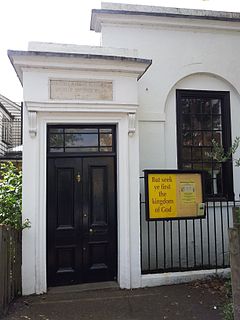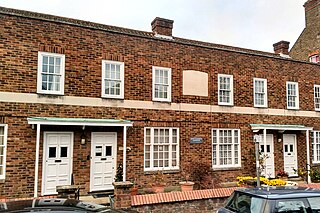
Kew is a district in the London Borough of Richmond upon Thames, 1.5 miles (2.4 km) north-east of Richmond and 7.1 miles (11.4 km) west by south-west of Charing Cross; its population at the 2011 census was 11,436. Kew is the location of the Royal Botanic Gardens, now a World Heritage Site, which includes Kew Palace. Kew is also the home of important historical documents such as Domesday Book, which is held at The National Archives.

Sir (George) Gilbert Scott, styled Sir Gilbert Scott, was a prolific English Gothic revival architect, chiefly associated with the design, building and renovation of churches and cathedrals, although he started his career as a leading designer of workhouses. Over 800 buildings were designed or altered by him.

Richmond Park, in the London Borough of Richmond upon Thames, was created by Charles I in the 17th century as a deer park. The largest of London's Royal Parks, it is of national and international importance for wildlife conservation. The park is a national nature reserve, a Site of Special Scientific Interest and a Special Area of Conservation and is included, at Grade I, on Historic England's Register of Historic Parks and Gardens of special historic interest in England. Its landscapes have inspired many famous artists and it has been a location for several films and TV series.

Richmond is a town in south-west London, 8.2 miles (13.2 km) west-southwest of Charing Cross. It is on a meander of the River Thames, with many parks and open spaces, including Richmond Park, and many protected conservation areas, which include much of Richmond Hill. A specific Act of Parliament protects the scenic view of the River Thames from Richmond.

Froxfield is a village and civil parish in the English county of Wiltshire. The parish is on the Wiltshire-West Berkshire border, and the village lies on the A4 national route about 3 miles (4.8 km) west of Hungerford and 7.5 miles (12 km) east of Marlborough.

Richmond Green is a recreation area located near the centre of Richmond, a town of about 20,000 inhabitants situated in south west London. Owned by the Crown Estate, it is leased to the London Borough of Richmond upon Thames. The Green, which has been described as "one of the most beautiful urban greens surviving anywhere in England", is essentially square in shape and its open grassland, framed with broadleaf trees, extends to roughly twelve acres. On the north-east side there is also a smaller open space called Little Green. Richmond Green and Little Green are overlooked by a mixture of period townhouses, historic buildings and municipal and commercial establishments including the Richmond Lending Library and Richmond Theatre. On summer weekends and public holidays the Green attracts many residents and visitors. It has a long history of hosting sporting events; from the 16th century onwards tournaments and archery contests have taken place on the Green, while cricket matches have occurred since the mid-18th century, continuing to the present day.

Whiteley Village, in Hersham, Surrey, England, is a retirement village, much of it designed architecturally by Arts and Crafts movement-influenced architect Reginald Blomfield. It is owned by the charitable Whiteley Homes Trust and is on land which was once part of Walton Firs and Walton Heath, before the parish of Hersham was created in the 19th century.

The Hospital of St Cross and Almshouse of Noble Poverty is a medieval almshouse in Winchester, Hampshire, England. It has been described as "England's oldest and most perfect almshouse". Most of the buildings and grounds are open to the public at certain times. It is a Grade I listed building.

Gray's Almshouses is a terrace of almshouses in Taunton, Somerset, England, founded in 1635 by the wealthy cloth-merchant Robert Gray, whose monument survives in the Church of St Mary Magdalene. The building is one of the oldest surviving in Taunton and is one of the earliest brick buildings in the county. The Almshouses were designed to provide accommodation for six men and ten women and for a reader who was to act as chaplain and schoolmaster. It is a grade I listed building as designated by English Heritage. Following renovation in the late twentieth century it now comprises sheltered accommodation of nine flats for the elderly.

St Mary Magdalene, Richmond, in the Anglican Diocese of Southwark, is a Grade II* listed parish church on Paradise Road, Richmond, London. The church was built in the early 16th century but has been greatly altered so that, apart from the tower, the visible parts of the church date from the 18th, 19th and early 20th centuries.

Bethlehem Chapel, Richmond is an independent Calvinistic chapel on the east side of Church Terrace in Richmond, London. Built in 1797, the small one-storey stuccoed building is Grade II* listed. It still has its original galleried interior with pews and pulpit.

Queen Elizabeth’s Almhouses, Richmond are almshouses in Richmond, London, founded by Sir George Wright in 1600 to house eight poor aged women. Known originally as the "Lower almshouses", they were built in Petersham Road, a few hundred yards south of what is now Bridge Street. By 1767, they were almost derelict. In 1767, William Turner rebuilt the almshouses on land at the top end of his estate in The Vineyard. Funds for the rebuilding were raised by public subscription. The almshouses were rebuilt again in 1857. They were damaged during World War II and replaced with four newly built houses in 1955.

The Richmond Charities is an almshouse charity based in the London Borough of Richmond upon Thames with its origins dating back to 1600. The charity provides affordable housing for people in housing need. It also administers two relief-in-need welfare charities, a relief-in-sickness charity and a very small charity that awards small quarterly grants to four deserving spinsters.

Bishop Duppa’s Almshouses, Richmond are Grade II listed almshouses in Richmond, London. They were founded by Brian Duppa, Bishop of Winchester, in 1661 to house ten unmarried women aged over 50.

Houblon's Almshouses are Grade II* listed almshouses in Richmond, London. They were founded in the 18th century by two sisters, Rebecca and Susanna Houblon, whose father, Sir John Houblon, had been the first Governor of the Bank of England. The oldest almshouses were built in 1757, originally to house nine poor women who had been brought up in the Protestant religion. A further two almshouses were built in 1857.

Michel's Almshouses are Grade II listed almshouses in Richmond, London, located in The Vineyard, opposite Bishop Duppa's Almshouses and Queen Elizabeth's Almshouses. They were founded in the 1690s by Humphrey Michel. The original ten almshouses were built in 1696 and were rebuilt in 1811. Another six almshouses were added in 1858.

Church Estate Almshouses are Grade II listed almshouses in Richmond, London, located on Sheen Road, near Hickey's Almshouses. Most of the buildings, which were designed by William Crawford Stow, date from 1843 but the charity that built them is known to have existed in Queen Elizabeth I's time and may have much earlier origins.

The William Portman Almshouses in Staple Fitzpaine, Somerset, England was built in 1643. It is a Grade II* listed building.






















